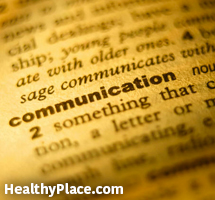Three Ways to Have Healthy Communication
There are many ways to have healthy communication. My family's communication style is not even remotely what I would call healthy. For example, I mentioned I had an upset stomach on Christmas Eve, and my mother said that if that were the case I needed to go home before the festivities started. I took this to mean that I was not welcome and left shortly after gifts were opened. Hurt feelings could have been avoided by phrasing this in a healthy manner (Healthy Communication In Relationships). Here are three ways to have healthy communication.
For Healthy Communication, Use "I" Statements
 It's been said many times before, but it's worth repeating--when disagreements arise, use "I" statements. If you start a sentence with "you," such as "You make me mad when you . . ." it automatically puts the other person on the defense. An "I" statement, such as "I feel angry when . . ." will help the other person to see it from your perspective (but Communication In Abusive Relationships Is A Myth).
It's been said many times before, but it's worth repeating--when disagreements arise, use "I" statements. If you start a sentence with "you," such as "You make me mad when you . . ." it automatically puts the other person on the defense. An "I" statement, such as "I feel angry when . . ." will help the other person to see it from your perspective (but Communication In Abusive Relationships Is A Myth).
This takes a lot of practice because it's human nature to blame someone else. A "you" statement is a defense and the first step toward an argument. A "you" statement puts the other person on the receiving end of an attack. Interestingly enough, a "you" statement gives the other person power--by saying "you make me so mad," we're giving the other person control over our emotions.
"I" statements take responsibility. By saying "I" we're owning up to our emotions. We're presenting a problem in hopes of a joint effort to solve it. An "I" statement doesn't attack--it presents another perspective. An "I" statement invites dialogue and sharing. And that's a way to have healthy communication (Communicating Assertively).
Healthy Communication and the T.H.I.N.K Method
There's a little acronym I like that applies here--"T.H.I.N.K. before you speak." Is it True? Is it Helpful? Is it Important? Is it Necessary? Is it Kind? If the answer to any of these is "No," it's best not to say it.
If it isn't true, then we have no business saying it. As a pastor once observed about gossip, "The more interesting it is, the more likely it is to be false." Spreading rumors and misinformation damages trust, the underlying principle of healthy communication.
If it isn't helpful, why bother saying it? The object of healthy communication is to solve a problem, not win a battle. And consider whether or not help is appropriate. If there's one thing nearly 30 years in journalism has taught me, it's that people love to criticize in the guise of offering aid.
If it isn't important, don't bother saying it. Focus on the issue at hand. Be sure to present the facts and fully disclose all the information needed.
If it isn't necessary, stay quiet. As my mother once told me before a dinner with some political movers and shakers, "It's better to stay quiet and be thought a fool than to speak up and remove all doubt." Just as idle hands are the devil's workshop, idle words are the devil's slingshot.
If it isn't kind, it is just murder by character assassination. If it isn't kind, it won't contribute to the dialogue in a healthy manner. If it isn't kind, it's the start of an argument, not a solution of a problem.
Healthy Communication and Considering Another's Perspective
The more you know about the other person, the better you can gauge their communication style. This is vital to healthy communication because when we are talking to another person, we need to adopt their frame of reference, their perspective. We need to be aware that they may not see things the way we do, and that's okay. We are trying to solve a problem, and sometimes that means looking at it from more than one direction.
A crisis intervention officer once told the Indianapolis Star that when the police were dealing with a suicidal individual, they tried to look at the problem from the person's perspective--while killing yourself after failing a math test may not make sense to an adult, it may make perfect sense to a teenager. While most communication is not this desperate, it's still good to remember that what may seem silly to us may be serious to another person.
So that's three ways to have healthy communication. Use "I" statements. "T.H.I.N.K." before you speak. Consider the other person's perspective. Remember, healthy communication builds bridges and tears down walls, not the other way around.
You can also find Becky Oberg on Google+, Facebook and Twitter and Linkedin.
APA Reference
Oberg, B.
(2015, December 28). Three Ways to Have Healthy Communication, HealthyPlace. Retrieved
on 2025, December 24 from https://www.healthyplace.com/blogs/recoveringfrommentalillness/2015/12/three-ways-to-have-healthy-communication
Author: Becky Oberg
One guarantee in life is someone will say something stupid. Often that person is me.
The THINK acronym is good. Just remember:
Be kind.
Be helpful or nice.
Love your neighbor ( fellow mankind) as yourself.
People are strange. We live in the ME generation. That is why we have selfies and Facebook.